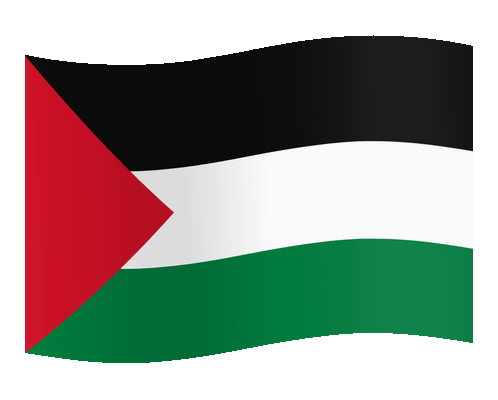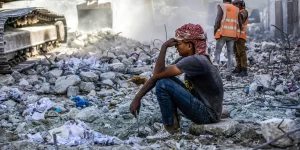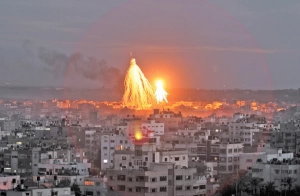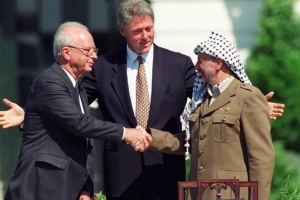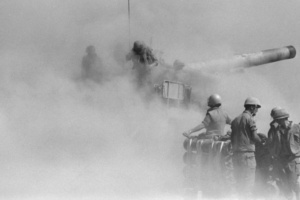The grassroots protests of 1987 escalated into full-blown riots involving much of civil society, from organisations, union groups to newly created institutions to the ordinary population who came out in large numbers on to the streets led by rock-throwing youths.
As the protest movement developed, more sophisticated missiles, such as the Molotov cocktail, were used and occasional operations by resistance fighters against the Israeli occupation forces and its installations were carried out.
Israel reacted by killing and deporting Palestinian residents, closing universities and making mass arrests. By December 1987 a full-scale uprising had broken out in the Gaza Strip. It continued for five years.
Inventive tactics
The Intifada (or popular uprising) marked a new era in mass resistance in Palestine, signalling an end to years of passivity. Lacking the necessary arms to face the Israeli military, people in the occupied territories invented their own ways of fighting back. Many young men took to wearing masks and ambushing the Israeli army with a rain of stones.
One interesting mode of asserting independence was when Palestinians rejected Israel’s daylight-saving time and worked to their own clock.
Initially the Intifada was led by the Unified National Command, a loose grouping of Palestinian Liberation Organisation (PLO) bodies. Later, the PLO incorporated with the command to take credit for leading the Intifada.
 |
|
Hamas members parade in the |
Hamas (the Islamic Resistance Movement) defied the secular national movement, especially in Gaza, and sought to take over the leadership of the Intifada. It saw the new developments as a deliberate relinquishment of the rights of the Palestinian people. Hamas continued to carry out field operations against the Israeli forces, insisting that armed resistance was the only way to win back Palestinian rights.
The Intifada developed more sophisticated tactics. The military operations and stone-throwing were backed by a network of well organised strikes, the boycotting of Israeli goods, closures and demonstrations.
Refugees’ resistance
The refugee camps became major centres for action. The goals of the Intifada won broad sympathy from the governments and people of Arab and Muslim countries, while Arabs in Israel took the side of their blood brothers.
They considered the Intifada to be a rebirth of the 1976 uprising, later known as the “day of the land”, which saw demonstrations and strikes in protest against the confiscation of Arab land for use by Jewish settlers in the north of Israel.
In June 1988, a new way of resistance to back the stone-throwers was adopted. Palestinian resistance fighters set fire to 500 Israeli interests over a 27-day period.
Israel had demanded the international community put pressure on the Intifada leaders to give up armed resistance. Yet, in July 1988 the Israeli authorities did not prevent a group of Jewish extremists from digging a new tunnel between the two Islamic holy sites in Jerusalem, al-Buraq Wall and the al-Aqsa mosque.
Appeal to the people
Muslim clerics, through mosque loudspeakers, appealed to the people to defend their holy sites. Muslim Arab Palestinians rushed to stop the digging. The Israeli police forces were brought in leading to bloody clashes in and around al-Aqsa.
Later, fighting spread throughout Palestine. There were dozens of Palestinian casualties. A state of emergency was declared, and Palestinian cities, towns and villages were put under siege. Schools and universities were closed.
 |
|
The Intifada carried on during
|
The Intifada carried on throughout the early 1990s. On 9 October 1990 Israeli forces killed 19 Palestinians in clashes with stone-throwers, and in December 1992, 413 Palestinians were deported to the inhospitable borders with Lebanon.
As the first Gulf war was underway in 1991, Iraq ceased to be a major power in the Middle East. The Palestinians felt that they had lost a substantial backer, and this resulted in rapid developments in the Arab-Israeli conflict.
The peace process, started in Madrid in 1991, led to secret negotiations in Oslo, Norway, and by 1993 Arafat recognised Israel’s right to exist and signed a peace agreement.
In 1994, the Palestinians were given limited autonomy in parts of the occupied Palestinian territories. By that time, tension began to ease and the popular uprising petered out, amid high hopes for a better future.
According to the Israeli Information Centre for Human Rights in the Occupied Territories, BTselem, 1124 Palestinians lost their lives in the first Intifada. Some 16,000 were imprisoned and many were routinely tortured. Fewer than 50 Israeli civilians were killed.
